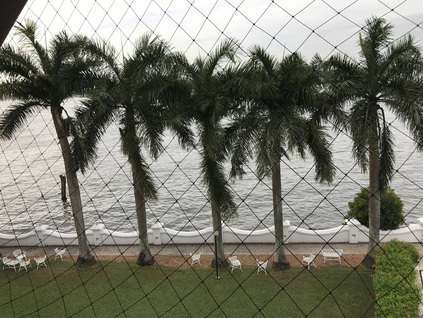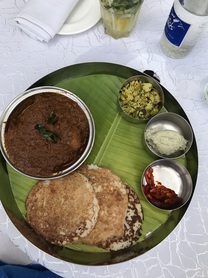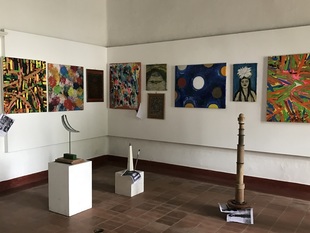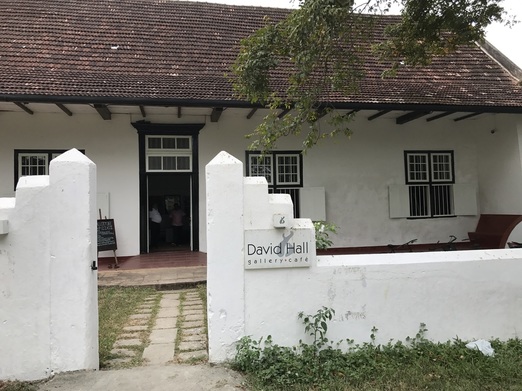South India's Relaxed Culture
 Swaying palms at Brunton Boatyard. The nets obstruct the view from my room but also keep the birds and eagles from harming themselves and being uninvited guests.
Swaying palms at Brunton Boatyard. The nets obstruct the view from my room but also keep the birds and eagles from harming themselves and being uninvited guests. Having toured through North India and Rajasthan, land of the Maharajas, last year, I now wanted to see the South and explore wellness in this region. I'm on a 3 week journey that will take me not only to South India but through Sri Lanka as well.
Even though I arrived in the wee hours of the morning into Cochin, in the state of Kerala, I could already tell there was a vast difference in culture from North and South India. Where Delhi and North India are marked by heavy traffic, the incessant honking of car horns, people rushing to and fro, the South is quite the opposite. My first impression reminded me of a tropical island with its swaying palm trees and smiling residents. This was confirmed by my travel host who picked me up from the airport and ensured I was settled into my hotel, The Brunton Boatyard. He concurred that North India is cosmopolitan and hectic and that the South is where Indians come to relax and find peace and a sense of calmness.
North India has many monuments and national treasures that are predominantly from the British rule. The South, specifically Cochin, has a mix of Dutch, Portuguese and British influences. The architecture, the food, and the history showcase the melding of cultures that impacted this region when these European nations sent trading ships here.
Even though I arrived in the wee hours of the morning into Cochin, in the state of Kerala, I could already tell there was a vast difference in culture from North and South India. Where Delhi and North India are marked by heavy traffic, the incessant honking of car horns, people rushing to and fro, the South is quite the opposite. My first impression reminded me of a tropical island with its swaying palm trees and smiling residents. This was confirmed by my travel host who picked me up from the airport and ensured I was settled into my hotel, The Brunton Boatyard. He concurred that North India is cosmopolitan and hectic and that the South is where Indians come to relax and find peace and a sense of calmness.
North India has many monuments and national treasures that are predominantly from the British rule. The South, specifically Cochin, has a mix of Dutch, Portuguese and British influences. The architecture, the food, and the history showcase the melding of cultures that impacted this region when these European nations sent trading ships here.
Luxury Redefined

As a connoisseur of luxury travel, I pride myself on seeking out the best experiences and accommodations. In Cochin, my home is Brunton Boatyard-a luxury hotel focused on eco-friendly practices. Coming from Northern California, I'm no stranger to notions such as "saving our planet" and "farm to table". It was very refreshing to see that this hotel company is also focused on doing just that. Given that Brunton Boatyard is in Fort Cochin, a UNESCO World Heritage site, it does of course exemplify all the elements of a historical hotel. Although not a heritage property itself, the hotel goes to great lengths to preserve and reflect the period elements of a bygone era. The site is that of a Victorian ship building yard, where George Brunton and his sons achieved great fame and prominence by building trading vessels of the highest quality. Brunton Boatyard, however, is a fairly new hotel developed some 20 years ago. However, this hotel goes beyond just architectural beauty, it takes great pains to ensure that this special place is benefitting the environment through it's use of solar panels, water purification and treatment, fresh organic food, while still preserving the culture and values of the local people. You won't find any plastic used here, even the water provided in the rooms are in glass bottles. As a matter of fact, this water is collected on property and put through a purification system in house before it's sealed and delivered to the guest rooms. With a shelf life of just 2 days, the water is refreshed and recycled regularly.
As for the meals, it's all "farm to fork" as they say here at Brunton Boatyard. Everything from the fish to the spices are purchased fresh from local markets. There is no preservation of any kind, including freezing, so if a menu item is no longer available in the markets or if supply runs out, the restaurant simply stops serving it. There is also nothing "white" or processed here-the breads are whole grain or whole wheat, the sugar and salt are raw, and the word "buffet" is not on the menu. It's amazing that I can come so far and yet still feel so much at home. The meals are outstanding-rivaling some of the best Northern California restaurants. This just goes to show that we can take care of ourselves and eat healthy, even while on vacation. There is also an Ayurveda Center at the resort which provides a host of massage and body treatment options. Given that I'm going to spend a week at a wellness center in Marari soon, I decided to forego (as tempting as they were) the massage treatments here.
Who says luxury has to be over-the-top indulgence? It can also be found in smaller boutique hotels that still retain the high service standards and beautiful accommodations you would expect, yet have an eye for sustaining our environment and giving back to the local people and economy. That's the new twist on luxury.
As for the meals, it's all "farm to fork" as they say here at Brunton Boatyard. Everything from the fish to the spices are purchased fresh from local markets. There is no preservation of any kind, including freezing, so if a menu item is no longer available in the markets or if supply runs out, the restaurant simply stops serving it. There is also nothing "white" or processed here-the breads are whole grain or whole wheat, the sugar and salt are raw, and the word "buffet" is not on the menu. It's amazing that I can come so far and yet still feel so much at home. The meals are outstanding-rivaling some of the best Northern California restaurants. This just goes to show that we can take care of ourselves and eat healthy, even while on vacation. There is also an Ayurveda Center at the resort which provides a host of massage and body treatment options. Given that I'm going to spend a week at a wellness center in Marari soon, I decided to forego (as tempting as they were) the massage treatments here.
Who says luxury has to be over-the-top indulgence? It can also be found in smaller boutique hotels that still retain the high service standards and beautiful accommodations you would expect, yet have an eye for sustaining our environment and giving back to the local people and economy. That's the new twist on luxury.
A Glimpse of Cochin

Although I'm taking this first day in India to recover from the long flights, I did go out to explore a taste of the tremendous art culture of Cochin. David Hall is a beautiful old Dutch bungalow that has been transformed into a cultural center with a gallery for contemporary art, which provides a platform for young artists to showcase their work . It also has a garden cafe where local artists and admirers can mingle and share their love of the craft. During this visit, I had the pleasure of meeting Joshe George Joseph, an talented sculptor and painter, and getting a personal tour of his work. Joshe was commissioned by the Government of India to create a series on Telepathism, which takes the form of many vibrant and eclectic pieces of work.
Fort Kochi also hosts a biannual event called the Kochi-Muziris Biennale which opens on December 12 and runs for 3 months. This international exhibition of contemporary art is organized by the Kochi Biennale Foundation whose primary objective is to promote art, culture and education in India. The last event in 2014 drew 500,000 visitors from 30 countries. They are hoping to exceed that number with this year's event. I wish I was still in the area in December-it sounds like an incredible experience!
Fort Kochi also hosts a biannual event called the Kochi-Muziris Biennale which opens on December 12 and runs for 3 months. This international exhibition of contemporary art is organized by the Kochi Biennale Foundation whose primary objective is to promote art, culture and education in India. The last event in 2014 drew 500,000 visitors from 30 countries. They are hoping to exceed that number with this year's event. I wish I was still in the area in December-it sounds like an incredible experience!


 RSS Feed
RSS Feed